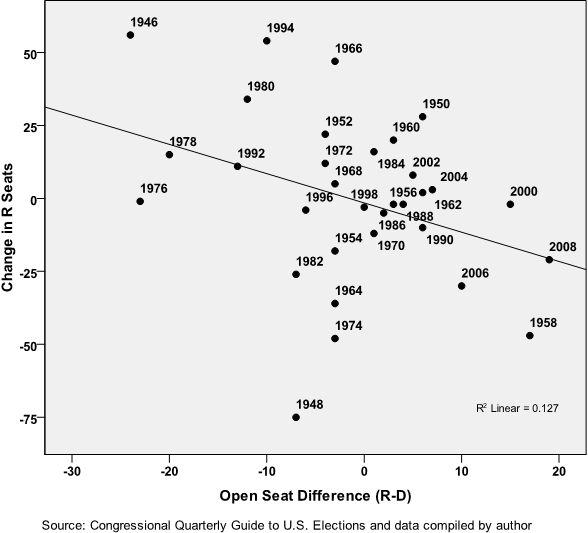Recent announcements by four Democratic incumbents from marginal or Republican-leaning districts that they will not run for reelection next year have set off a wave of speculation by pundits and strategists over whether a wave of such retirements could put Democrats in serious danger of losing control of the House of Representatives in the 2010 midterm elections. In the wake of the recent retirements, the National Journal’s Charlie Cook observed, “this business of whether the GOP can or will capture a majority next year is based on a lot of moving parts, but one of the most critical is Democratic retirements in tough districts.” Texas Representative Pete Sessions, the chair of the National Republican Congressional Committee, went even further and claimed, “Democrats are beginning to see the writing on the wall, and instead of choosing to fight in a difficult political environment, they are taking a pass and opting for retirement.”
Such speculation seems a bit premature given that no wave of Democratic retirements is evident thus far: to date only eleven House Democrats have announced their retirements compared with twelve Republicans and that the numbers of potentially vulnerable open seats in each party appear to be very similar. More importantly, though, discussion of the potential implications of incumbent retirements begs the question of whether the relative numbers of Republican and Democratic open seats actually has any impact on the outcomes of House elections.
At first glance, the importance of open seats in House elections might seem obvious. It is well known that races for open seats are much more likely to be competitive and to produce switches in party control than races involving incumbents. In 2008, for example, Democrats scored a net gain of 21 seats of which 13 came from open seats. In assessing the impact of open seats on House election outcomes, however, one must take into account the influence of national political conditions on incumbent retirements. The fact that there were 25 open Republican seats in 2008 compared with only 6 open Democratic seats reflected a political environment in late 2007 and early 2008 that was already toxic for the GOP as a result of President Bush’s low approval ratings and a deteriorating economy. These conditions, and not the incumbent retirements themselves, may have been primarily responsible for the outcome of the election. It is possible that many of the vulnerable incumbents would have lost their seats if they had run. This suggests that the relationship between incumbent retirements and election outcomes may be spurious.
An examination of data from all 32 House elections since World War II reveals that the relationship between open seats and the outcomes of these elections is actually fairly weak. There were 31 elections in which one party had fewer open seats. In 18 of these elections the party with fewer open seats made gains. However, in 13 of these elections the party with more open seats made gains. Figure 1 displays a scatterplot of the relationship between open seat differential (Republican open seats minus Democratic open seats) and net seat change for these 32 elections. The correlation between these two variables is -.36. As expected, the larger a party’s open seat differential, the more seats it tends to lose. However, open seat differential only explains about 13 percent of the variation in net seat change. Some elections in which there were large open seat differentials, such as 1976 and 2000, produced very small seat swings. And some elections in which there were small open seat differentials, such as 1966 and 1974, produced very large seat swings.
Figure 1. Seat Swing by Open Seat Difference in U.S. House Elections, 1946-2008

National seat swing in House elections can be predicted very accurately by a forecasting model based on five variables–the number of seats each party holds going into the election (which measures exposure to risk) the generic House ballot and net presidential approval (which measure national political conditions) and dummy variables for first and second midterm elections (which measure the tendency of voters to punish the president’s party in midterm elections regardless of national political conditions). These five variables explain almost 90 percent of the variation in seat swing in postwar congressional elections.
Table 1. Results of Regression Analysis of Seat Swing in U.S. House Elections

We would like to know whether open seat differential adds any explanatory power to our model of House seat swing. According to the results displayed in Table 1, the answer appears to be “no.” When a variable measuring open seat differential is added to the original regression equation, the proportion of variance explained by the equation is unchanged and the size of the estimated coefficient for the open seat variable does not come close to reaching statistical significance.
Conclusions
Based on the evidence presented in this article, open seats appear to have little or no influence on the outcomes of House elections. Rather, seat swing in these elections is a reflection of other factors such as the number of seats each party holds going into the election, the national political environment and the normal tendency of voters to turn against the president’s party in midterm elections. These factors suggest that Democrats are likely to suffer losses in the House of Representatives in the 2010 midterm elections. Based on the most recent Gallup Poll presidential approval and generic ballot results, a loss of between 20 and 30 seats would be expected. The actual results will depend on political conditions next fall. They will not depend on how many Democratic and Republican incumbents choose to retire in the next few months.
